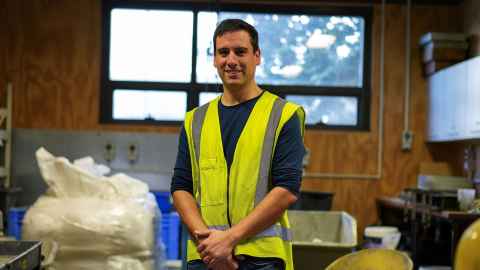Low carbon concrete blends Roman engineering with mātauranga Māori
17 June 2025
Concrete's carbon footprint is massive, but a University of Auckland researcher is using pumice and seashells to create a low-emissions alternative rooted in local wisdom.

At the Structures Testing Laboratory in Newmarket, Dr Enrique del Rey Castillo is developing a low-carbon concrete alternative that’s made to last.
Made using a blend of volcanic ash (pumice) and kaimoana shells as partial replacements for cement, the material may have self-healing properties, with small cracks capable of mending themselves over time.
Concrete is one of the world’s most polluting materials, with global cement production responsible for 5-8 percent of total CO2 emissions.
Del Rey Castillo has spent nearly seven years exploring how natural, locally sourced materials could create more sustainable alternatives. In 2023, he received a $360,000 Marsden Fund grant to support the research.
"As a civil engineer, as a researcher at the University of Auckland, it’s my duty to try and mitigate this issue and leave the world in a better place," he says.
He began experimenting with more conventional cement substitutes like fly ash and steel slag, before turning his attention to what Aotearoa New Zealand has in abundance.
"I realised we have a huge potential in New Zealand with the use of natural volcanic materials and byproducts of primary industries, which can be used as a cement replacement," he says.
Traditional cement is created by heating clay and limestone to 1500 degrees Celsius – a process known as calcining, which consumes large amounts of fossil fuels. About 40 to 45 percent of concrete’s carbon footprint comes from burning these fuels, and another 45 percent from the chemical reactions that occur when calcining limestone.
Pumice, on the other hand, doesn’t require calcining. It just needs to be dried at 100 degrees to remove moisture, then ground down to a fine powder.
"Because we don’t need to calcine it, the carbon footprint is about 8-10 percent the carbon footprint of cement. So for every kilo we are removing of cement, we are removing about 800 grams of CO2," Del Rey Castillo explains.
His research is being carried out in partnership with mana whenua, who are affected by the impacts of traditional concrete production and also stand to benefit from more sustainable use of these natural resources.
While materials like pumice and seashells have been used in various ways by Māori in the past, their potential for concrete production hasn't been thoroughly explored until now.
Del Rey Castillo’s research also draws inspiration from ancient Roman engineering, which used concrete made from burnt limestone and volcanic ash. In his version, seashells take the place of limestone.
"Burning limestone releases CO2 trapped by animals years ago, but burning seashells doesn’t add new carbon to the cycle, so that’s further reducing the emissions," he says.
"This way of thinking aligns very well with mātauranga Māori, protecting the environment and building things that are made to last, not just for this quarter, but for our grandchildren’s children."
New Zealand’s aquaculture industry generates an estimated 100,000 tonnes of shell waste annually, and though not all of it is usable, Del Rey Castillo estimates that 40-50 percent of it can be used as cement, including shells from kina (sea urchin) and kuku (mussels) .
One of the more exciting possibilities is the material’s potential to self-heal, he says.
Roman concrete is known to have contained unreacted lime particles. When water seeped into cracks, it triggered chemical reactions that created crystals and sealed the gaps.
"That’s why we have Roman concrete that has lasted 2000 years. We’re trying to understand that process a little better in the current environment."
Although the self-healing stage is still about a year away in his research, the use of pumice concrete is already proven overseas.
"New Zealand is a bit slower at adopting new technology, but we know it works because we’ve seen it in other parts of the world," he says.
"Nevertheless, I think we should start with low spec applications like footpaths, kerbs, nonstructural elements, perhaps small house foundations, things that we know are very low risk and build from there."
Media contact
Jogai Bhatt | Media adviser
M: 027 285 9464
E: jogai.bhatt@auckland.ac.nz